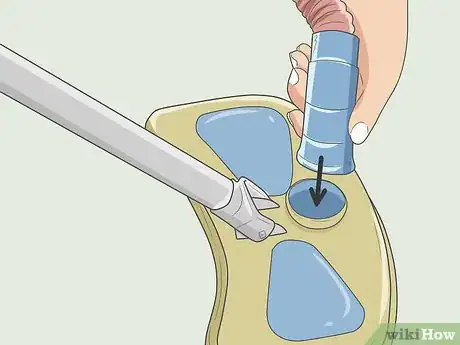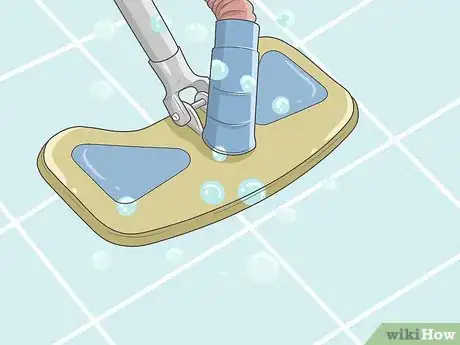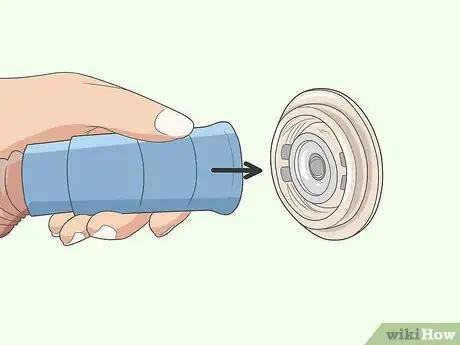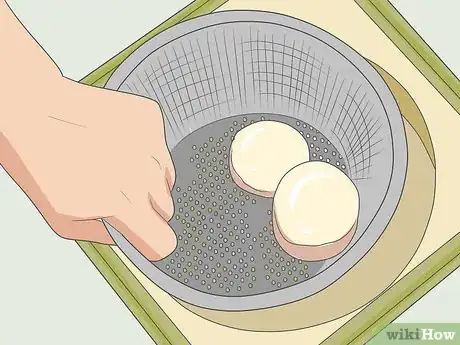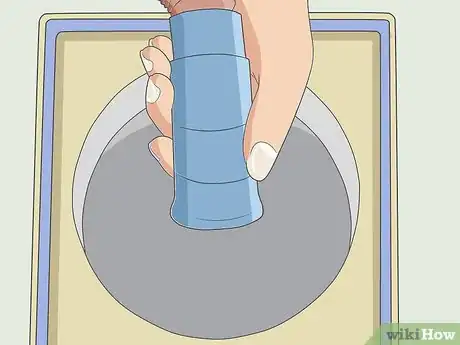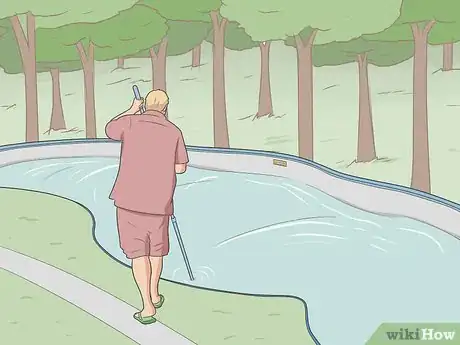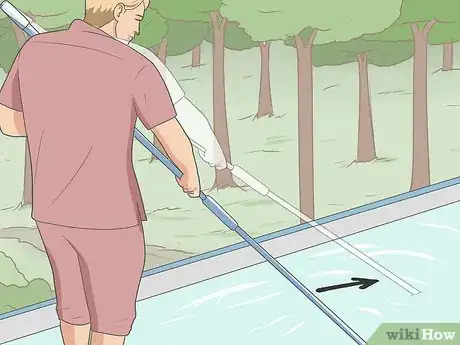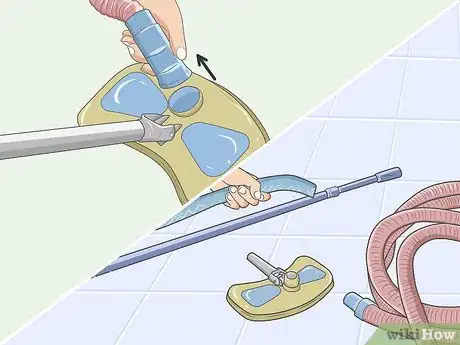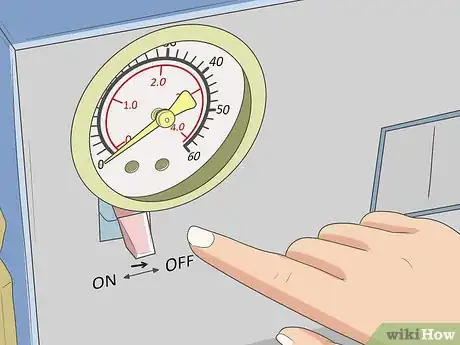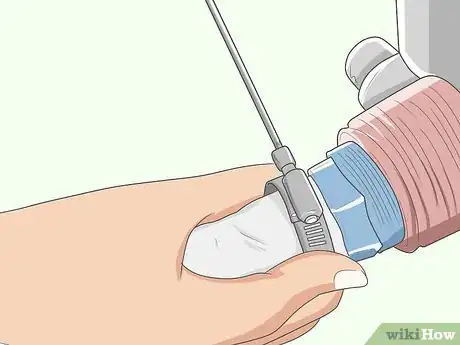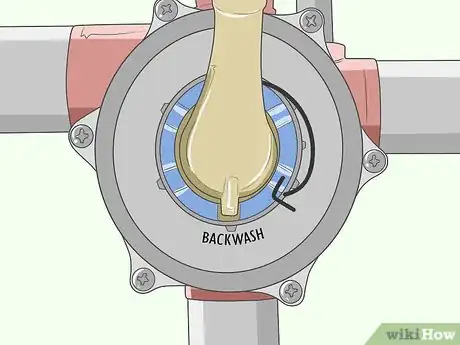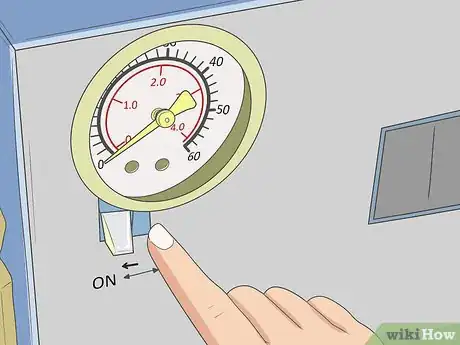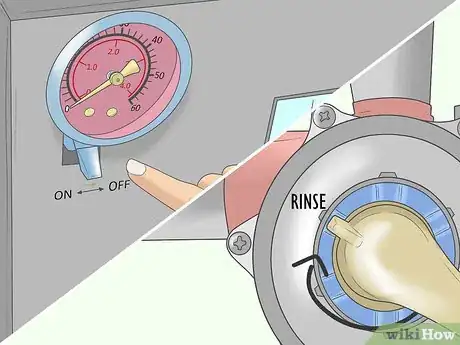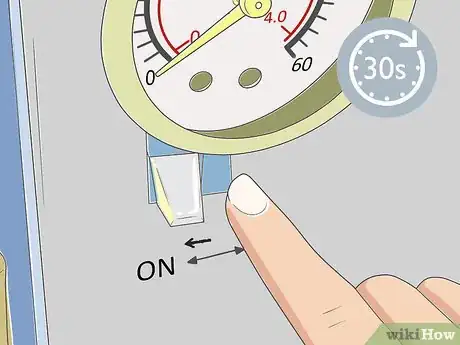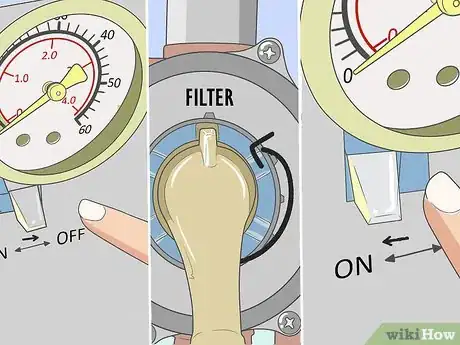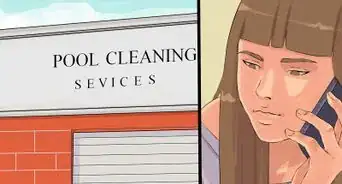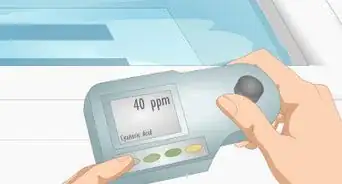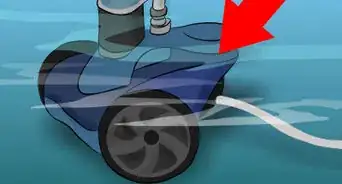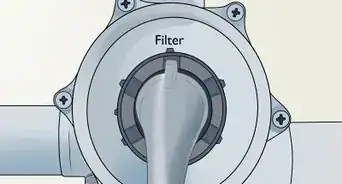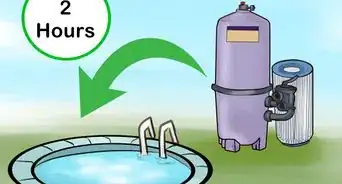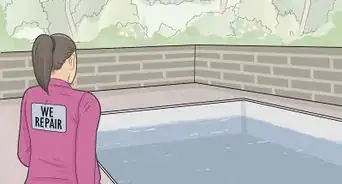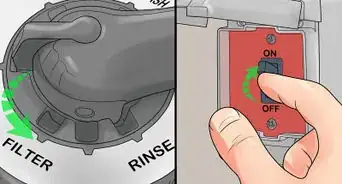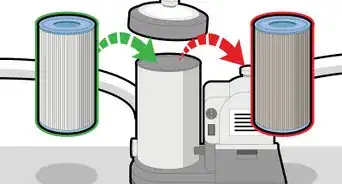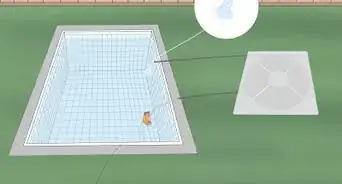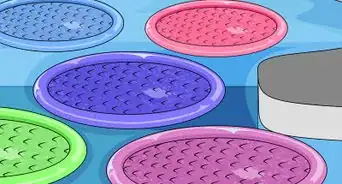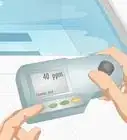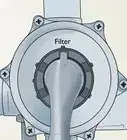This article was co-authored by Rob Litman. Rob Litman is a Landscaper, General Contractor, and the CEO of Vitoli Inc., a landscaping, hardscaping, ecoscaping, and swimming pool design company in Los Angeles, California. With over 20 years of experience in construction, Rob specializes in energy-efficient and drought-tolerant landscaping. He holds General Building Contractor (Class B) and Registered Pool/Spa Contractor Licenses. In 2007, Rob won House of the Year in Gardena, California.
There are 15 references cited in this article, which can be found at the bottom of the page.
This article has been viewed 753,001 times.
Over time, your pool will accumulate dirt and debris at the bottom and you will need to vacuum it to clean it. This is easy to do yourself with a pool vacuum head, a vacuum hose, and a telescopic pole. Whenever you perform routine pool cleaning and maintenance, it’s also a good idea to check the pressure gauge on your pool’s filter to see if it is higher than normal, meaning it has accumulated debris, and needs to be backwashed. Backwash your pool using the multiport valve and a backwash hose to clean out the filter and get it back to the normal operating pressure.
Steps
Vacuuming the Pool through the Skimmer
-
1Attach a telescopic pole and a vacuum hose to a pool vacuum head. A telescopic pole is an extendable pole that screws onto various attachments. Screw the vacuum head onto the pole and then push 1 end of a vacuum hose onto the raised round opening for the hose.[1]
- Make sure the hose is long enough that you will be able to walk around the perimeter of your pool and cover all the surface area of the bottom of the pool.
- A pool vacuum head is a simple vacuum head that has a hole to screw a pole or other attachment into, as well as a cylindrical opening for the hose that sticks up from the head that you push the hose onto. They come in a variety of shapes, from rectangular to triangular. You can get one online or at a pool supply shop.
-
2Submerge the vacuum head to the bottom of the pool. Hold the pole and extend it so it is long enough to reach the bottom. Push the vacuum head down slowly into the pool until it reaches the bottom.[2]
- Start at the edge of the pool near a return jet, which is the jet that pushes water back into your pool after it gets filtered, so you can easily reach it with the hose.
Advertisement -
3Hold the other end of the hose against a return jet to fill the hose with water. Place the open end of the hose against the return jet so it covers the jet stream. Watch the bubbles coming up from the vacuum head at the bottom of the pool and remove the hose from the jet when bubbles stop rising from the vacuum head.[3]
- Don’t lift the open end of the hose out of the water yet or you might end up spilling out the water you just filled it with.
-
4Take the basket out of the pool skimmer. The pool skimmer is what sucks loose debris off the surface of the water and filters it out before it has a chance to sink to the bottom. Locate the intake for the skimmer at the edge of the pool near the top of the deck, remove the plastic cover from the pool’s deck near the intake, and lift out the basket.[4]
- This will expose the skimmer’s suction hole that you need to use to vacuum your pool.
-
5Place the open end of the hose into the open suction hole in the skimmer. Hold your hand over the open end of the hose and aim it upwards to keep all the water in it as you lift it out of the pool. Lower it into the water where the skimmer basket was, keeping your hand against the opening until it is under the water, and place the opening of the hose in the suction hole.[5]
- This will supply suction to the vacuum hose that will allow you to vacuum the bottom of your pool with the vacuum head.
Tip: You can also attach a skimmer vacuum plate to the open end of the hose. This is a plate that is specifically designed to go on the end of the hose and then cover the pool skimmer’s suction hole to make a secure connection.[6]
-
6Start vacuuming at the shallow end and work towards the deep end. Stand at the edge of the shallow end and slowly work your way along the pool, ending at the deep end. This will allow you to extend the telescopic pole more as you move deeper into the pool and you won’t have to constantly change the length of the pole.[7]
- Make sure to keep an eye on the pool filter’s pressure gauge while you vacuum. If you see the pressure start to rise above the normal operating level, then backwash the filter to remove debris that is clogging it.
-
7Vacuum with long, slow, sweeping strokes. Go slow and steady so you don’t stir up debris into the water where you won’t be able to actually vacuum it up. Overlap your strokes so you don’t miss any sections.[8]
- If you start disturbing debris that clouds up the water, then stop and wait for 1-2 hours to let the debris settle down before continuing to vacuum.
-
8Disconnect and rinse everything when you have vacuumed the whole pool. Unscrew the telescopic pole from the pool vacuum head and pull the hose off. Hold the hose up vertically to drain any remaining pool water out. Rinse everything with fresh water from a garden hose and let it air dry before storing it.[9]
- Remember to vacuum your pool whenever you start to notice debris such as dirt and leaves accumulating at the bottom of the pool. It’s also a good idea to vacuum your pool every time you backwash the filter.
- You should vacuum the pool once a week to keep it in good shape.[10]
- Vacuuming helps to maintain the color of the pool water. Otherwise, it may become Tahoe blue or gray.
- It is an affordable method because most vacuums cost less than $200.[11]
Backwashing Your Pool’s Filter
-
1Turn the filter’s on/off switch to the off position. Locate the on/off switch on your pool’s filter, usually near the pressure gauge, and switch it off. Always do this to turn off the filter before you move the multiport valve to backwash the filter or you could break the diverter gasket inside the valve.[12]
- When the pressure gauge on your sand filter reads 10 psi above its regular level, or the level it operates at when you first set up the filter, then you need to backwash the filter. If you aren’t sure what the normal operating level is, then consult the owner’s manual.
-
2Connect the backwash hose to the backwash nozzle with a hose clamp. Slide the hose clamp over the end of the backwash hose and put the end of the hose over the backwash nozzle of the filter system. Turn the screw on the hose clamp clockwise with a screwdriver until it is tightened all the way to make a secure connection.[13]
- There will be a lot of water pressure when you backwash the filter system, so it’s important to make sure the hose is very tightly attached to the backwash nozzle so it doesn’t pop off during the procedure and spill pool water everywhere.
Warning: Check with your local water and sewer authority regarding where you are allowed to drain pool water. You might be allowed to run the other end of the backwash hose into a storm drain or a plumbing cleanout of your home, but it’s important to make sure you are following local regulations to avoid fines and environmental damage.
-
3Turn the multiport valve from the filter position to the backwash position. Locate the multiport valve on the filter system, in other words the valve labeled with different functions, and turn the handle to the position labeled “backwash.” This will change the function of the filter to allow you to drain water through the backwash nozzle.[14]
- Double-check the filter’s on/off valve to make sure it is off before you move the multiport valve to avoid damaging the filter system.
-
4Turn the filter on and let it run until the water runs totally clear. Turn the filter’s on/off valve back to “on” and watch the water in the sight glass. You are done backwashing when the water in the sight glass looks clear.[15]
- This usually takes about 1 minute, but the time can vary depending on how dirty the filter is.
-
5Turn the filter off and move the multiport valve from backwash to rinse. Switch the filter’s on/off valve to “off.” Turn the handle of the multiport valve to the spot that says “rinse”.[16]
- The rinse function will flush out any remaining dirt and debris from the filter before you turn it back on.
-
6Turn on the filter and let it run for 30 seconds. Switch the filter on again to start the rinse function. Let it run for around 30 seconds to flush out the last of the dirt and debris through the backwash hose.[17]
- The water will look clear at this point, so just count to 30 and then you are done rinsing.
-
7Switch the filter off, set the multiport valve to filter, and turn the filter on. Turn off the filter to stop the rinse function. Switch the multiport valve handle back to the “filter” position and turn the filter back on to start filtering the pool as normal again.[18]
- The pressure gauge of the filter will now read at its regular operating level again.
Community Q&A
-
QuestionDoes the swivel end of the vacuum hose go in the skimmer or on the vacuum head?
 Community AnswerThe vacuum end. It will allow air to be sucked in if it's out of the water.
Community AnswerThe vacuum end. It will allow air to be sucked in if it's out of the water. -
QuestionHave I done any damage by vacuuming the pool with the filter in the rinse mode?
 Community AnswerAssuming you are doing this with a sand filter, you have done no damage. Sand filters are forgiving; however, your method is causing you more work because after vacing in the Rinse mode, you will then need to Backwash, causing even more water loss. You want to vac on the Waste setting.
Community AnswerAssuming you are doing this with a sand filter, you have done no damage. Sand filters are forgiving; however, your method is causing you more work because after vacing in the Rinse mode, you will then need to Backwash, causing even more water loss. You want to vac on the Waste setting. -
QuestionWhen I vacuum my pool, everything comes back out of the filter. What am I doing wrong?
 Community AnswerPossibly, you are attempting to vacuum on the wrong setting. Vacuuming should be done on the Filter setting, and remember to prime the vacuum hose before attempting to vacuum.
Community AnswerPossibly, you are attempting to vacuum on the wrong setting. Vacuuming should be done on the Filter setting, and remember to prime the vacuum hose before attempting to vacuum.
Things You’ll Need
Vacuuming the Pool through the Skimmer
- Pool vacuum head
- Vacuum hose
- Telescopic pole
- Skimmer vacuum plate (optional)
- Garden hose
Backwashing Your Pool’s Filter
- Backwash hose
- Screwdriver
- Hose clamp
References
- ↑ https://www.youtube.com/watch?v=FyTorswJT6Q&feature=youtu.be&t=33
- ↑ https://www.youtube.com/watch?v=FyTorswJT6Q&feature=youtu.be&t=37
- ↑ https://www.youtube.com/watch?v=FyTorswJT6Q&feature=youtu.be&t=42
- ↑ https://www.youtube.com/watch?v=FyTorswJT6Q&feature=youtu.be&t=49
- ↑ https://www.youtube.com/watch?v=FyTorswJT6Q&feature=youtu.be&t=55
- ↑ https://www.youtube.com/watch?v=wGjkCszDa-k&feature=youtu.be&t=86
- ↑ https://www.swimuniversity.com/vacuum-pool/
- ↑ https://www.swimuniversity.com/vacuum-pool/
- ↑ https://www.swimuniversity.com/vacuum-pool/
- ↑ https://www.forbes.com/advisor/home-improvement/how-to-vacuum-a-pool/
- ↑ https://www.forbes.com/advisor/home-improvement/how-to-vacuum-a-pool/
- ↑ https://www.youtube.com/watch?v=_-FPtfSFACM&feature=youtu.be&t=08
- ↑ https://www.youtube.com/watch?v=_-FPtfSFACM&feature=youtu.be&t=12
- ↑ https://www.youtube.com/watch?v=_-FPtfSFACM&feature=youtu.be&t=43
- ↑ https://www.youtube.com/watch?v=_-FPtfSFACM&feature=youtu.be&t=52
- ↑ https://www.youtube.com/watch?v=_-FPtfSFACM&feature=youtu.be&t=69
- ↑ https://www.youtube.com/watch?v=_-FPtfSFACM&feature=youtu.be&t=73
- ↑ https://www.youtube.com/watch?v=_-FPtfSFACM&feature=youtu.be&t=87
